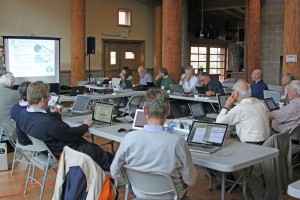The most obvious benefit of the seemingly endless series of reviews we undergo comes from the rigours of doing our preparations. But the reviews also serve to validate our work, and perhaps most importantly, the review committees give us good advice in their reports. Last autumn, we had a two-day technical review of the Global Design Effort by the Project Advisory Committee (PAC), a subcommittee of the International Linear Collider Steering Committee (ILCSC). Several recommendations came out of that PAC review that have been quite helpful to us as we prepare to make final decisions on the proposed new baseline configuration for the ILC Technical Design Report (TDR).
The PAC review was held on 11 and 12 Nov 2010 at the University of Oregon in Eugene with Jim Brau serving as the local host. The committee report is generally quite supportive of the GDE programme and made some specific recommendations. The committee consists of accelerator and detector experts from around the world: Jean-Eudes Augustin, CNRS/IN2P3; Jon Bagger, Johns Hopkins University (ILCSC Chair, ex officio); Lyn Evans, CERN (Chair); Stuart Henderson, Fermilab; Steve Holmes, Fermilab; Akira Masaike, Kyoto; Robert Orr, Toronto; Roy Rubinstein, Fermilab (Secretary); and Masakazu Yoshioka, KEK, who were all in attendance. Katsunobu Oide, KEK and Raj Pillay, TIFR, also PAC members, were unable to attend.
Last spring at their prior review, the PAC recommended that we take steps to improve communication and collaboration between the accelerator and detector communities, specifically with regard to the process of deciding on proposed changes to the ILC baseline. Some of the changes have implications on ILC physics performance, making it particularly important to include the physics community in evaluating them.
We followed that good advice and took active steps to include experimentalists in both the working meetings and the dialogue, which was aimed at answering questions and developing consensus on the changes. I also included detector representation on the Change Assessment Panel that advised me on the final decisions. To emphasise their point at the November meeting, the PAC decided to set a good example by integrating the agendas for both the ILC accelerator and the detector presentations.
That meeting provided validation for the process we are employing towards making decisions on the technical baseline design. But perhaps the most interesting PAC recommendation concerned another topic: how to approach fabrication of the very large number of cavities that will be needed for the ILC. So far both the European XFEL project at DESY and the GDE R&D programme have focused on developing ‘expert’ companies, that is, companies capable of mastering the detailed processes required to produce high-gradient cavities. However, looking towards the process for large-scale mass production, the PAC suggested we work towards the approach that was used at CERN for the LHC magnets. In that case, CERN basically assumed responsibility for integrating individual components and for achieving the required performance, significantly relieving risks from industry.
In general, this philosophy uses industry for what they are best able to do and should thereby lower costs. The pilot plant that we are in the process of developing at KEK is a step in this direction, as it both reduces infrastructure requirements for industry and puts more central responsibility on the laboratory for technology transfer and performance. Our approach to this whole issue will evolve in the future, informed next by a second series of visits by the project managers to key vendors, who will get their inputs on how best to develop superconducting radio frequency technology toward mass production.
The PAC meets twice per year and the next scheduled meeting will be held at Academia Sinica in Taiwan this coming May. By that time, we will have finalised the TDR baseline and will have begun work towards the technical design. Once again, we will work hard and benefit from our preparations for that review, but I am also confident that the PAC’s insights and recommendations will provide valuable guidance and improve our prospects for producing a solid TDR that can then serve as the basis of a global construction project.




Recent Comments